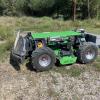Coverage Path Planning for Autonomous Ground Robots
The proposed technology integrates the Automated Guided Vehicle (AGV) with the Unified Planning Framework (UPF) through a Technology-Specific Bridge (TSB), enabling dynamic path planning and efficient obstacle navigation.
Categories

Short Description
This project describes the development of a Task and Motion Planning (TAMP) system for Autonomous Ground Vehicles (AGVs). AGVs are mobile robots that can navigate and perform tasks in various environments, and are equipped with sensors to perceive and understand their surroundings. TAMP is a crucial technology that allows AGVs to operate autonomously and perform a wide range of tasks by generating a plan that defines the sequence of actions the AGV should take to perform a given task while taking into account the AGV's capabilities, the constraints of the environment, and any obstacles that the AGV may encounter.
Solution
The proposed technology bridges the AGV and the UPF (Unified Planning Framework) library, providing the AGV with TAMP capabilities by managing the communication between the AGV and the UPF, translating information about the AGV's state and providing it to UPF, and transforming the plan generated by the UPF into a format that the AGV can understand and execute. Its primary aim is to offer full coverage path planning capabilities using the library. Additionally, the TSB will be able to respond to changes in the environment and the AGV's state by providing the UPF with new data and refeeding the AGV with a plan optimized in the updated conditions.
The project requirements dictate a consistent geometry of the field, encompassing robot obstacles, optimization cost, and GNSS-RTK denied areas. These constant maps, along with static robot characteristics such as AGV dimensions and effective cutting area, are to be preloaded and parsed by the Technology-Specific Bridge (TSB). The TSB is expected to preprocess the combined preloaded data, parsing static maps in raster format and dividing them into grid cells of optimal dimensions based on robot characteristics, resulting in a generalized symbolic map.
Once initialized with static content, the TSB is designed to accept user input for plan computation. Users will provide a 2-dimensional polygon representing a segment of the general map. The TSB is responsible for translating this polygon into a gridded map, utilizing preloaded data. Subsequently, the area is further partitioned to expedite path planning. The TSB then provides each partition to the UPF, merging the resulting paths before returning the output to the robot's navigation stack. This methodology ensures efficient handling of static and user-provided data, facilitating the seamless integration of the TSB into the overall system.
Although the TSB will be evaluated in the case of Orestis, it will be developed, based on general principles that apply in many cases of AGVs planning. It will be developed as a Python library, primarily dependent on UPF. the TSB can be installed as a Python package in any recent Linux Python environment. The TSB can be run either in the cloud as a service, or on-board if the AGV has the capability. Both the source code and its documentation will be publicly available under the Apache 2.0 license.
Impact
The project has yielded notable impacts across key success indicators. The achieved ratio of obstacle-free coverage in the workspace 2D map surpasses the target at 92.05%, showcasing an effective solution for navigating around obstacles. The reduction in commissioning time is exceptional, exceeding 98%, indicating a highly efficient and streamlined process. While there's an 11% increase in cutting area given the battery capacity, falling short of the 20% target, it still signifies improved efficiency. Additionally, the project has successfully reduced grass cutting operation time by 12%, demonstrating a positive impact on overall operational efficiency. Overall, the Technology-Specific Bridge (TSB) implementation has proven successful, particularly in obstacle avoidance and commissioning efficiency.